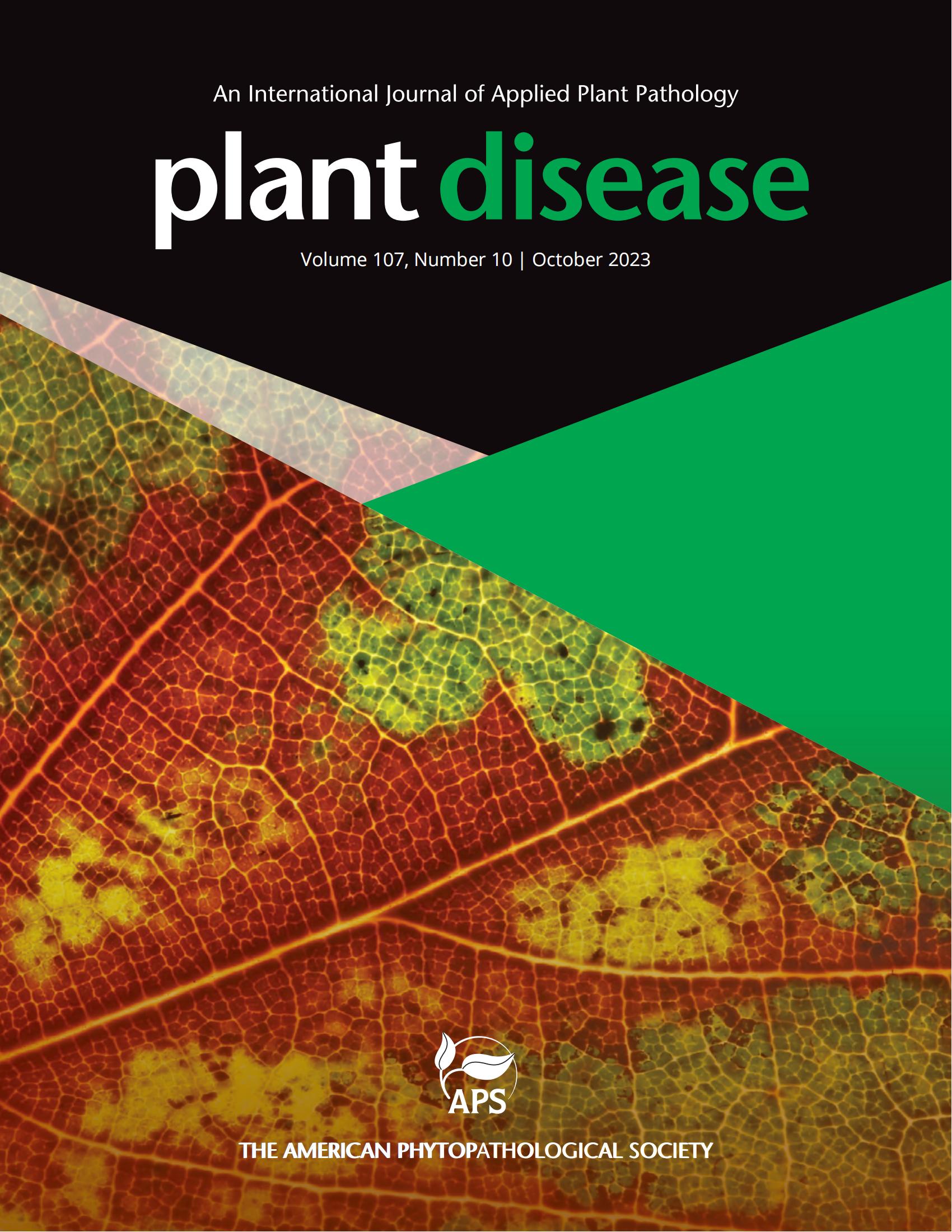中国首次报告辣椒轻度斑驳病毒感染辣椒(Capsicum annuum L.)
摘要
据报道,荷兰(García-Luque等人,1993年)、日本(Hamada等人,2003年)、保加利亚(Ruíz del Pino等人,2003年)和以色列(Luria等人,2018年)的辣椒(Capsicum annuum L.)感染了红辣椒轻微斑驳病毒(PaMMV),这是一种病毒科的托布病毒。辣椒已成为种植面积最广的蔬菜和消费量最大的辛辣调味品,在中国的种植面积很大(>21,000 平方公里)(邹等人,2021 年)。然而,该作物的产量受到病毒病的限制。2021 年 8 月,在中国山东省临沂市的五个辣椒种植区进行了一次病毒病调查,结果显示,大多数田块中有 5%至 10%的植株表现出发育不良、叶片变窄、萎蔫和叶片组织皱缩等症状(图 S1-a)。随后,从一块种植薄皮辣椒的地块(东经 118°29',北纬 34°65')采集了 7 个症状样本(图 S1-b)。使用烟草花叶病毒(TMV)多克隆抗体进行 Western 印迹检测,所有样本均呈阳性,表明存在烟草花叶病毒(图 S1-c)。为鉴定病毒,使用 RNeasy Plant Mini Kit(QIAGEN,Hilden,Germany)从 10 个不同症状的辣椒植株样本中提取总 RNA,并等量(每个 100 ng/μL)合并成一个样本。使用 Illumina NovaSeq 6000(Illumina,美国圣地亚哥)对该混合物进行 RNA 序列分析。使用内部 perl 脚本对 fastq 格式的原始读数(6.92G)进行处理,得到干净的读数(6.68G),并使用 Trinity 软件(v2.6.6)将其组装成 780 个等位组(平均长度:2036 bp)。然后使用 NCBI BLASTX 程序(http://www.ncbi.nlm.nih.gov/blast)对照病毒 RefSeq 数据库对这些等位基因进行分析。结果显示,等位基因的平均基因组覆盖率为 40.16%。值得注意的是,一个独特的等位基因(6453 bp)与 PaMMV 基因组(参考序列 KX187305.1)有 98.34% 的一致性。为了验证 RNA-Seq 的结果,研究人员设计了一对 PaMMV 特异引物(正向:5'-GAGTTCATAGAGGCAGTACC-3';反向:5'-CTTCGATTTAAGTGGAGGGAT-3'),用于通过 RT-PCR 扩增 PaMMV 衣壳蛋白(CP)基因的 800-nt 片段。从所有症状样本中成功扩增出了 800-nt 片段(图 S1-d)。根据 BLAST 分析,RT-PCR 产物(GenBank 编号:OR365081.1)与 PaMMV 分离物(OQ198318.1,中国,山羊)的核苷酸一致性为 99.75%。从临沂采集的三株受感染的辣椒植株上将 PaMMV 机械传播给健康的辣椒植株证实了其致病性。三个辣椒栽培品种(商品名:祁门、天宇、昊农11)在接种后出现了不同的症状(图 S1-e)。实验室证实所有栽培品种都对 PMMoV 敏感,接种 PMMoV 后表现出明显的病毒病症状(数据未显示)。每个品种至少接种了 3 株来自不同田间采集毒源的幼苗。祁门(栽培品种:甜椒)表现出严重的坏死斑症状,天宇(栽培品种:朝天椒)出现轻微的叶片皱缩,昊农 11 号(栽培品种:泡椒)出现黄色斑驳和叶片萎缩。通过 RT-PCR 检测,所有受试幼苗均对 PaMMV 呈阳性反应(图 S1-f)。据我们所知,这是中国首次报道辣椒感染PaMMV病毒,这突出表明有必要进行警惕性监测,以保护辣椒产业并防止病毒传播到其他作物。Paprika mild mottle virus (PaMMV), a tobamovirus from the Virgaviridae family, has been reported to infect pepper (Capsicum annuum L.) in the Netherlands (García-Luque et al., 1993), Japan (Hamada et al., 2003), Bulgaria (Ruíz del Pino et al., 2003), and Israel (Luria et al., 2018). Pepper has become the most widely planted vegetable and the most heavily consumed spicy condiment, with a large planting area (>21,000 km2) in China (Zou et al., 2021). However, the crop's productivity is limited by viral diseases. In August 2021, a survey of viral diseases was conducted across five pepper-growing regions in Linyi, Shandong Province, China, revealed that 5% to 10% of plants in most fields exhibited symptoms such as stunting, leaf narrowing, chlorosis, and crinkling of leaf tissue (Fig. S1-a). Subsequently, seven symptomatic samples (Fig. S1-b) were collected from a plot (118° 29' E, 34° 65' N) where thin-skinned peppers were grown. All samples tested positive in a Western blot assay using a polyclonal antibody for tobacco mosaic virus (TMV), indicating the presence of a tobamovirus (Fig. S1-c). To identify the virus, total RNAs were extracted from 10 different symptomatic pepper plant samples, using the RNeasy Plant Mini Kit (QIAGEN, Hilden, Germany) and combined into a single sample in equal amounts (100 ng/μL each). RNA-Seq was performed on this mixture using the Illumina NovaSeq 6000 (Illumina, San Diego, USA). Raw reads (6.92G) in fastq format were processed with in-house perl scripts to yield clean reads (6.68G), which were assembled into 780 contigs (mean length: 2036 bp) using Trinity software (v2.6.6). These contigs were then analysed using the NCBI BLASTX program (http://www.ncbi.nlm.nih.gov/blast) against the viral RefSeq database. The results demonstrated that the contigs exhibited an average genome coverage of 40.16%. Notably, one unique contig (6453 bp) was mapped to the PaMMV genome (reference sequence KX187305.1) with 98.34% identity. To verify the RNA-Seq result, a PaMMV-specific primer pair (forward: 5'-GAGTTCATAGAGGCAGTACC-3'; reverse: 5'-CTTCGATTTAAGTGGAGGGAT-3') was designed for amplifying an 800-nt fragment of the PaMMV coat protein (CP) gene by RT-PCR. The 800-nt fragment was successfully amplified from all the symptomatic samples (Fig. S1-d). Sequenced RT-PCR products (GenBank No. OR365081.1) showed 99.75% nucleotide identity with PaMMV isolates (OQ198318.1, China, goat) according to BLAST analysis. Mechanical transmission of PaMMV from three infected pepper plants collected in Linyi to healthy pepper plants confirmed pathogenicity. Three pepper cultivars (trade name: Qiemen, Tianyu, Haonong11) were tested and showed varying symptoms post-inoculation (Fig. S1-e). All cultivars were confirmed in the lab to be PMMoV-sensitive and exhibited significant viral disease symptoms after PMMoV inoculation (data not shown). Each variety was inoculated with at least 3 seedlings from different field-collected virulence sources. Qiemen (cultivar: sweet pepper) exhibited severe symptoms with necrotic spots, Tianyu (cultivar: Chaotian pepper) had mild leaf wrinkling, and Haonong11 (cultivar: Pickled pepper) showed yellow mottle and leaf shrinking. All tested seedlings were positive for PaMMV by RT-PCR (Fig. S1-f). To our knowledge, this is the first report of PaMMV infecting pepper in China, highlighting the need for vigilant monitoring to protect the chili industry and prevent the virus's spread to other crops.

 求助内容:
求助内容: 应助结果提醒方式:
应助结果提醒方式:


